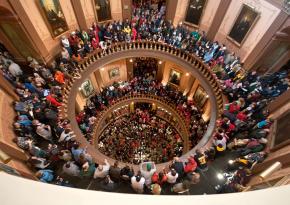Protesting a governor’s power grab
More than 3,000 people rallied March 16 at the Michigan state Capitol in Lansing to protest Republican Gov. Rick Snyder's budget package, including the new Emergency Financial Manager (EFM) program that allows the governor to nullify the state's collective bargaining agreements with public-sector unions as well as override, alter or even nullify local governments and school boards.
The rally took place as Snyder signed the bill into law. The governor now has the authority to appoint Emergency Financial Managers who will have dictatorial power over local governments and school districts. With the governor's approval,, the EFMs can "'disincorporate or dissolve' a municipal government. Local elected officials would be stripped of significant powers," according to one media report.
Michigan labor organized a protest at the Capitol March 16 that many expected to culminate in an occupation modeled on the actions in Wisconsin. Instead, only a small number of people participated in such action. and , members of the Southeast Michigan branch of Organization for a Free Society, report on labor's protest of the new law and the debate on whether to occupy the Capitol.
THE MARCH 16 protest against Gov. Rick Snyder, sponsored by the AFL-CIO, drew people from all over the state. Various labor and activist leaders made speeches denouncing Snyder's EFM proposal.
Throughout the day, speakers talked about occupying the Capitol, using phrases like, "This is our house, they can't make us leave our house." United Auto Workers (UAW) President Bob King openly advocated for nonviolent direct action from the podium. Lansing Mayor Virg Bernero even declared that no one would be arrested in Lansing for staying in the Capitol.
However, events went quite differently. The program on the Capitol steps almost seemed orchestrated to diffuse the crowd's energy by the end of the day, as talk of occupation slowly shifted to talking about electoral plans for 2012 and "winning the jobs of the future." People were directed to leave the Capitol in order to participate in the rallies that took place throughout the day.
Around 5 p.m., people began to filter back into the Capitol in an attempt to fill it before the doors would be locked at 5:30. Unfortunately, no one on the podium stopped to inform the crowd about what was happening, and as a result, many people who were intending on spending the night in the building never had a chance to get in.

As the occupation began, approximately 60 people remained in the Capitol aside from journalists and police officers, including some UAW members. Protesters inside were informed that someone was actively leading the crowd outside away from the Capitol. Police also began escalating the threats of arrest, and began pulling people out of the crowd.
Meanwhile, people were banging on the doors from the outside, and attempts were made to open the doors to let them in. However, the police had the rotunda surrounded. It became clear that the occupation could not be maintained, as people were slowly filtering out, reducing the number of protesters to about 30.
After a short discussion, a vote was held about whether to maintain the occupation or to leave. Five individuals (who would later be arrested for their actions) elected to stay, and the rest of us pledged our support and left in unison.
In spite of the larger crowd that had been outside clamoring to get in and earlier pledges from unions to occupy the Capitol on Wednesday night, local media has primarily dismissed those of us who briefly occupied the Capitol as angry youth with a "different agenda" than the union protesters, and it appears that both union leaders and Democratic politicians have complied with this portrayal.
To the best of our knowledge, no union leaders have publicly praised the actions of those who were arrested, but instead seem content to detach themselves from those who were willing to stage a more drastic--yet still absolutely peaceful and nonviolent--form of protest.
THE RESPONSE to our actions brings into sharp relief the need for solidarity and a unified movement. Our "agenda" is the same as that of rank-and-file workers: to stand up and fight an unjust budget that will eliminate collective bargaining for all work done under government contract; mandate a 5 percent pay cut for all public employees; eliminate the Earned Income Credit for low-income working families; and authorize Emergency Financial Managers to step in and replace the elected governments of our cities and towns. All this while giving tax breaks to corporations.
Snyder's budget will harm everyone in our state but the rich, and everyone in our state must stand together to fight it. By writing us off as nothing more than rowdy kids looking to cause trouble, the union leadership and Democrats are doing nothing but diffusing a potentially powerful and desperately necessary movement.
As we hear ourselves repeatedly labeled "young protesters" by the media and by law enforcement, we are struck first by the falsehood of such a label. Of the people who remained inside the Capitol after closing time on Wednesday afternoon, those who we know personally are nearly all working adults. Among our ranks are some with college degrees and some without, longtime union members, parents, and yes, students. It's deeply troubling that we live in a world where truly standing up for what we believe in is associated solely with some kind of youthful naiveté.
But equally troubling is this drawing of lines in the sand between "young protesters" and "rational, polite union members and Democrats." We cannot allow ourselves to be fractured. To build a real movement, we must focus on that which unites us, not that which divides us.
Those who are adversely impacted by Snyder's budget range from children to the elderly. We also must not forget the invaluable contributions that students and other youth have brought to struggles for justice in the past, or that historically many successful movements have originated as youth and student movements.
We call on union leadership to embrace the youth who wish to unite in the cause, rather than dismissing them as provocateurs with ulterior motives. And we call on the citizens of our state and of our entire country to realize that there comes a time to stop being polite.
Certainly everyone wants to behave rationally, but can it really be called rational to calmly sit by and allow our most basic rights and freedoms to be taken away? If history has taught us anything, it should be that sometimes acts of nonviolent civil disobedience are the most rational actions an oppressed people can take.
A unified movement is long overdue. It is time to break down the artificially constructed barriers that divide us and to recognize that an injustice to one of us is an injustice to all. Workers, students, women, youth, the elderly, people of color, LGBTQ individuals--the same forces are at work against all of us.
The budget that forces pay cuts for public employees and strips away their bargaining rights is the same budget that will drastically cut health care programs for the elderly, take away such vital services as transitional housing for victims of domestic violence, and deny health insurance to the domestic partners of state employees.
We must recognize that we have a common enemy. Those who wish to oppress us have power, wealth, big business, and the state on their side. And they know full well that when divided, we are not strong enough to fight them. By allowing ourselves to be fragmented and set in opposition against one another, we allow ourselves to be weakened. It is time for us--the people--to realize that solidarity is our greatest hope for strength.


